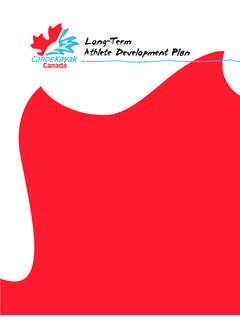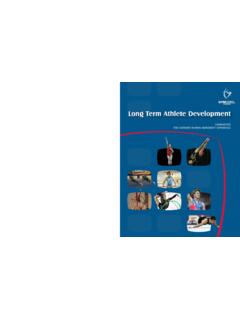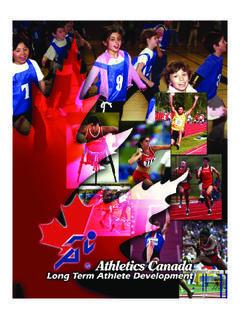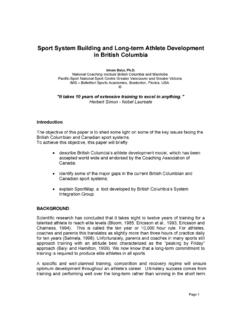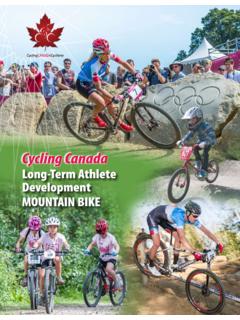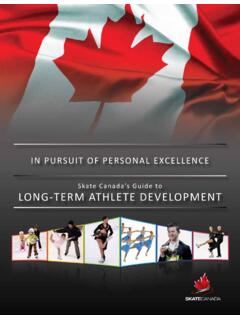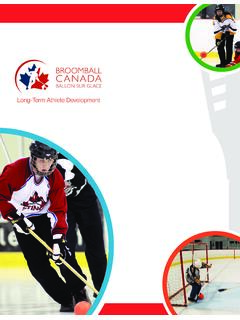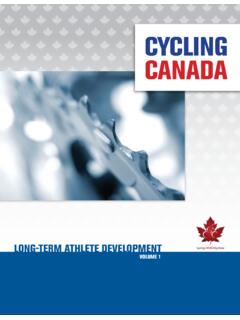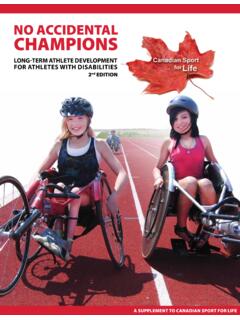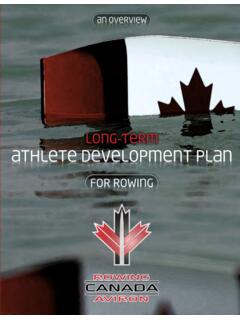Transcription of SLEEP, RECOVERY, AND HUMAN PERFORMANCE
1 sleep , recovery , ANDHUMAN PERFORMANCEA Comprehensive Strategy for long -Term Athlete DevelopmentCharles H. Samuels, MD, CCFP, DABSM & Brent N. Alexander, Post-exercise recovery and regeneration (PERR) is as important as the training regimen to the complex adaptive process of increasing athletic The foundation of PERR is sleep . sleep constitutes the passive recovery , regeneration and rest process. 2 Table of ContentsAUTHORSC harles H. Samuels, MD, CCFP, DABSM a,bBrent N. Alexander, aa. Centre for sleep and HUMAN PERFORMANCE #106, 51 Sunpark Drive Calgary, Alberta T2X 3V4, CANADA b. Department of Family Medicine University of Calgary G012, Health Sciences Centre 3330 Hospital Drive, Calgary, Alberta T2N 4N1, CANADAS leep, recovery , and Regeneration 3 sleep Length 5 sleep Quality 9 Insomnia 10 Obstructive sleep Apnea 11 Movement Disorders.
2 Parasomnias 12 Environmental sleep Disturbance 13 Mood Disorders 14 sleep Phases 15 Final Comments 16 sleep Recommendations 17 sleep Log 18 References and Selected Readings 193 sleep RecommendationsActive Start(Females & Males 0-6 years)Duration: 13-16 hrsQuality: Establish and maintain a sleep / nap routine Ensure a comfortable/safe sleep environment Avoid stimulation 1-2 hrs before bed; minimize screen time Phase: Consolidate nighttime sleep period Decrease naps to 1-2/day in the first year Natural light exposure first thing in the morningKey Points: Establish stable sleep routines and a bedtime routine Use a sleep transition object Introduce independent sleep initiating behaviorsSleep, recovery , and RegenerationThe effect of sleep on athletic PERFORMANCE has become a topic of great interest due to the growing body of scientific evidence that has demonstrated a relationship between critical sleep factors ( sleep length, sleep quality and circadian sleep phase) and HUMAN PERFORMANCE .
3 4 The role of sleep and the importance of sleep in long -Term Athlete development (LTAD) is the focus of this section. sleep , recovery , and RegenerationSleep factors have also been shown to have a direct effect on metabolic processes including energy balance, appetite and weight control. More importantly, sleep extension and circadian rhythm research in athlete populations has provided objective evidence that confirms the significance of these relationships and importance of considering sleep in LTAD. The relationship of sleep to PERR and PERFORMANCE can be viewed in a structured fashion. sleep length (total sleep requirement: hours/night), sleep quality ( sleep disorders, environmental disturbance or fragmentation), and sleep phase (circadian timing of sleep ) are the key factors affecting the overall recuperative outcome of the sleep state. These three parameters of sleep affect an athlete s ability to train, maximize the training response, and recover.
4 Most importantly, these parameters change over the course of an athlete s career and life. Therefore, the athlete, parents and coaches have to have strategies to adjust to the changing sleep requirements throughout the athlete s career. Finally, attending to the importance of sleep will reduce the risk of overtraining/under- recovery , enhance resistance to illness and improve recovery from is great interest and debate over the optimum amount of sleep ( sleep length) required for humans to recuperate and function normally. sleep requirements change over the course of an individual s life (figures 1 and 2). Figures 1 and 2 describe the general patterns of changes in sleep requirements and composition ( sleep stages) over the course of a lifetime and provide sleep researchers/educators with the information to guide the advice provided for the athletes . It is a safe assumption that based on training demands the sleep requirement for an athlete would be greater than for the average individual who is not an athlete.
5 Therefore, establishing guidelines for athletes at various stages in their career development for sleep requirement, providing tools to assess sleep patterns/routines accurately and implementing strategies to achieve the recommended amount of sleep are important practical interventions. It is very important for athletes , parents and coaches to be aware of the fact that at the time in life (12 18 years old) when adolescents require the most amount of sleep (9 10 hours per night) they tend to develop a delay in their biological clock (circadian sleep phase) that reduces the amount of time available for sleep . This results in a chronic sleep restriction during a time of increasing training demands, growth and development . 5 sleep RecommendationsFUNdamentals(Females 6-8, Males 6-9)Duration: 10-11 +30 min napbetween 2-4pmQuality: Maintain a regular sleep /nap routine Ensure a comfortable sleep environment Establish independent sleep initiating behaviors Observe sleep for sleep disordersPhase: Establish a neutral sleep pattern between 9pm and 8am.
6 Encourage predictable afternoon nap/rest Establish reliable meal routines (breakfast is the most important meal of the day)Key Points: Reinforce 15-30 min bedtime routine Avoid stimulation 1-2 hours before bed, control screen time Good nutrition and meal routines reinforce sleep routines object Introduce independent sleep initiating behaviors5 sleep LengthTotal sleep durationAge (months)Age (years))sruoh(noitarudpeelslatoT20191817 1615141312111098762019181716151413121110 98761 3 6 9 1 2 3 4 5 6 7 8 9 10 11 12 13 14 15 16 95%90%75%50%25%10%2%eg. at 2 years old, 45% sleep from hours to hours a dayeg. at 12 years old, 48% sleep from hours to hours a day Nighttime sleep durationAge (months)Age (years))sruoh(noitarudpeelsemitthgiN1413 12111098765 1 3 6 9 1 2 3 4 5 6 7 8 9 10 11 12 13 14 15 16 95%90%75%50%25%10%2 % 141312111098765(excludes naps, etc.)
7 Eg. at 14 years old, 48% sleep from hours to hours a dayFigure 1 a & b. Percentiles for total sleep duration and nighttime sleep duration per 24 hours from infancy to adolescence. Adapted from Iglowstein et al. 36 From a Canadian perspective, a sample of 272 National and Olympic Team athletes and coaches ranging from 15 to 57 years old were screened during the 2009 annual medical review. The results revealed a range of to hours of sleep per night with an average of hours of sleep per night in these athletes . A recent study of intercollegiate athletes by Mah (2011) at Stanford University found that increasing the nightly sleep period of 18-20 year old varsity basketball players to at least 10 hours, for a duration of 5-7 weeks led to faster sprint times, increased accuracy, and improved overall ratings of physical and mental well-being during practices and These results demonstrate a discrepancy between athletes behaviours (how much sleep they get) and athletes sleep requirements (how much sleep they need).
8 Therefore, it is important to establish sleep routines at the Active Start stage, maintain those routines insuring adequate sleep through the FUNdamental and Learn to Train stages (6 12 years old) and prepare for the challenges of getting adequate sleep (9 10 hours per night) during the Train to Train and Train to Compete stages (adolescence). This upfront effort will establish the importance of sleep and sleep routines for the demanding Train to Win stage so the added stress of travel can be more easily managed to reduce the impact of travel fatigue and jet lag. Figure 2. sleep staging variations and changes throughout the life span. sleep latency time to fall asleep, WASO wake after sleep onset, REM Dream sleep , SWS Slow Wave (Deep) sleep , Stage 1 and 2 Light sleep . Adapted from Ohayon et LengthSleep latencyWake After sleep OnsetREM - Dream SleepSlow Wave (Deep) SleepStage 2 Stage 1 Age 60050040030020010005 10 15 25 35 45 55 65 75 85 Minutes Slept7 sleep RecommendationsLearn to Train(Females 8-11, Males 9-12)Duration: +30 min napbetween 2-4pmQuality: Maintain a regular sleep /nap routine Ensure a comfortable sleep environment Observe sleep for sleep disordersPhase: Maintain Neutral sleep pattern Get early morning light exposure for 30 min.
9 Daily* Maintain reliable nutrition routines (breakfast is the most important meal of the day)Key Points: Maintain 15-30 min bedtime routine Monitor and control screen time Monitor caffeine intakeSleep Length The lack of sleep or cumulative sleep debt is associated with changes in mood, concentration, motivation, endurance and recovery that have a negative effect on PERFORMANCE and put the athlete at risk for overtraining/under- recovery . An athlete s total sleep requirement is the key to the foundation of PERR. The tools used to monitor sleep requirement are sleep logs (sample log on page 17). sleep logs can be used to determine current behaviors and then to develop training and recovery routines to match the sleep requirement. Strategies for getting enough sleep include napping. 81) Naps should be limited to 30 minutes. 2) Naps should be scheduled in the mid to late afternoon (2 4pm) but not after 4pm so it does not affect the athletes ability to fall asleep at bedtime.
10 3) Naps can be combined with a dose of caffeine, for the older athletes (cup of coffee either before or immediately after the nap). sleep LengthNaps should also be a part of the routine and follow simple rules. The combination of caffeine and napping has been shown to improve the restorative quality of the nap and post-nap alertness/concentration. It is paramount that the athlete determines the amount of sleep needed per week ( , 8 hours per day = 56 hours per week). This gives the athlete a sense of how much sleep they require and how much sleep debt they accumulate per week. With this information the athlete and support staff can develop sleep and napping strategies which will then dictate training routines with the ultimate goal of reducing cumulative sleep RecommendationsTrain to Train(Females 11-15, Males 12-16)Duration: 9 +30 min napbetween 2-4pmQuality: Ensure a comfortable sleep environment Initiate regular napping strategy Monitor for excessive sleepiness & fatigue Observe sleep for sleep disordersPhase: Maintain a regular sleep /nap routine Get early morning light exposure for 30 min daily* Monitor for a delayed sleep phase (difficulty falling asleep and waking up for school) Maintain reliable nutrition routines (breakfast is the most important meal of the day)Key Points.
